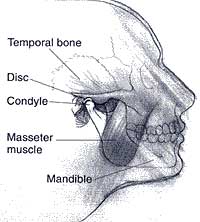Temporomandibular Joint Disorder (TMJ)
Speak to a DoctorTemporomandibular Joint Disorder (TMJ)
Temporomandibular joint (TMJ) disorder–also called TMJ syndrome–refers not just to one but to a number of conditions that cause pain in the face, head, or jaw area. The TMJs, located just in front of the ears, are the 2 hinged jaw joints that attach the lower jaw (mandible) to the bones at the sides and base of the skull (temporal bones). These joints allow the jaws to open, close, move side-to-side, and rotate in movements such as chewing, swallowing, or speaking. When there is pressure on the facial nerves from muscle tension–caused, for example, by clenching or grinding the teeth during the daytime or nighttime, bone abnormalities, arthritis, stress, or injury–a variety of symptoms may occur. These symptoms may include headache, earache, tooth sensitivity, jaw stiffness or soreness, or a clicking sound when the mouth opens or closes.
Temporomandibular joint disorder, which may be chronic (long-lasting) or temporary, affects more than twice as many women as men and most often appears between the ages of 20 and 50.

SOURCES
Uppgaard, RO . Taking Control of TMJ: Your Total Wellness Program for Recovering From Temporomandibular Joint Pain, Whiplash, Fibromyalgia, and Related Disorders . Oakland , Calif : New Harbinger Publications, 1999.
Temporomandibular Joint Association, Inc. Web site. Available at: http://www.tmj.org. Accessed March 14, 2005.
Jaw Joints & Allied Musculo-Skeletal Disorders Foundation, Inc. Web site. Available at: http://www.tmjoints.org. Accessed March 12, 2005.
USEFUL LINKS
- Academy of General Dentistry
Nonprofit organization of general dentists; also provides useful information on TMJ for patients.
http://www.agd.org - Temporomandibular Joint Association, Inc.
Nonprofit organization dedicated to providing information about TMJ.
www.tmj.org - Jaw Joints & Allied Musculo-Skeletal Disorders Foundation, Inc.
Nonprofit public awareness and advocacy organization; good source of information for patients.
http://www.tmjoints.org
-
How NUCCA Can Help
Although there are many possible causes of TMJ dysfunction, one of the most common is trauma, or injury. In head trauma, the upper cervical spine tends to misalign, and the vertebrae move out of their normal position (subluxate). This movement irritates the nerves that go to the muscles of the face and jaw.
NUCCA can help by correcting the misalignments of the upper cervical spine caused by trauma and remove the irritation of the affected nerves. After the nerve irritation has been removed, proper communication is restored between the brain and spinal cord, and the surrounding nerves.
Specific imaging studies of the cervical (upper neck) region are taken to locate a misalignment of the vertebrae. Insight Millennium technology is used to scan and measure the nervous system for possible irritation. If a misalignment has been found to affect the function of the nervous system, very specific, gentle adjustments are made, by hand, to correct the misaligned vertebrae in the neck. After the adjustment has been performed, follow-up imaging studies and nervous system scans are taken to confirm a successful spinal correction.
Conditions Helped
Subluxation, can cause issues throughout the body manifesting in a variety of diseases.
View our Conditions Helped pages to see a non-exhaustive list of conditions the NUCCA procedure may help with. For more information, give us a call.
We’re here for you

Your health is worth a 5-minute phone call.
Schedule a call back from one of our doctors.
or give us a call today: (914) 686-6200
Dr. George Gertner is a family man, healer, philanthropist, author of “The Gift of Hope”, public speaker, and founder of one of the world’s busiest Upper Cervical Chiropractic clinics.
After receiving his bachelors degree in biology from Hofstra University in Hempstead, NY Dr. Gertner moved to Atlanta, GA to attend Life University. Before graduation, Dr. Gertner had a severe injury to his lower back. Traditional chiropractic procedures were not providing relief until he met a chiropractor that specialized in NUCCA (National Upper Cervical Chiropractic Association.)
Then he spent the next two years mentoring from one of the best Upper Cervical doctors; learning in the same office that helped change his life. After two years, Dr. Gertner returned home to New York to open his own office. He currently is one of less than 300 NUCCA chiropractors worldwide.
Dr. Gertner has been featured numerous times in Chiropractic Monthly Magazine for his expertise in treating Trigeminal Neuralgia and Myofascial Pain. Dr.Gertner has lectured locally and nationwide discussing various symptoms using the Upper Cervical technique.
Reviewed by
Dr. George Gertner



